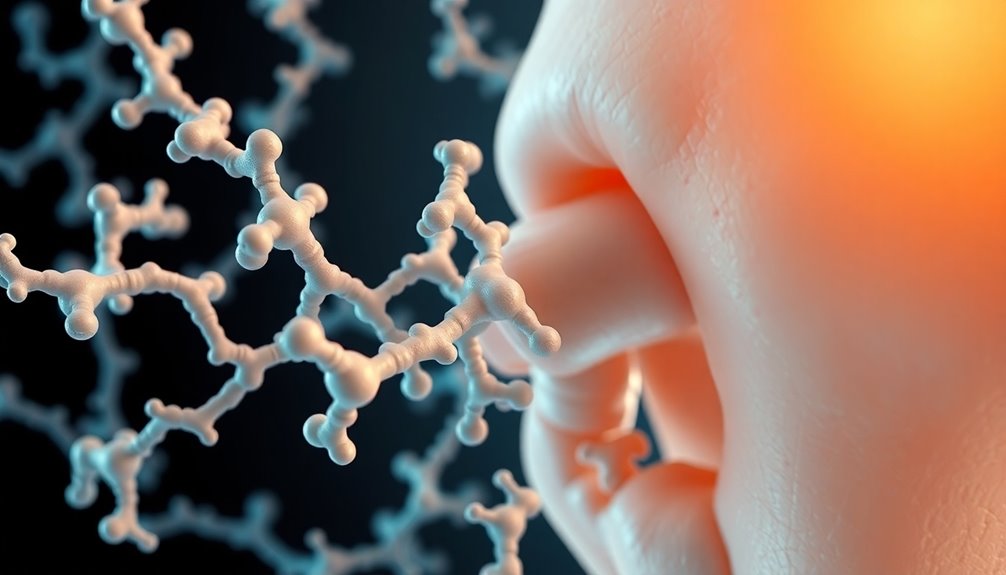Collagen Type IX's regulatory functions are pivotal for maintaining connective tissue integrity, essential in preventing age-related degeneration and autoimmune conditions. Through interactions with fibronectin and other proteins, it stabilizes cartilage matrix and contributes to joint health. Mutations affecting these interactions can weaken the matrix and impact overall joint function. Understanding how Collagen Type IX regulates cartilage structure sheds light on critical mechanisms for maintaining tissue integrity and preventing degenerative diseases. Its role in fiber diameter regulation and matrix stability underscores its importance in therapeutic development for joint health. Further insights into its regulatory functions can offer valuable knowledge on maintaining connective tissue integrity.
Key Takeaways
- Maintains cartilage matrix integrity through interactions with fibronectin.
- Regulates fiber diameter in cartilage matrix and near cells.
- Critical for proper structure and stability of connective tissues.
- Deficiencies increase susceptibility to autoimmune arthritis.
- Key in developing targeted therapies for degenerative joint diseases.
Type IX Collagen Structure
Type IX collagen, an important component in cartilage, plays a significant role in maintaining the structural integrity of the extracellular matrix (ECM). It's composed of three triple helical domains (COL1-3) and a unique NC4 domain that extends into the matrix from the collagen fibril surface. These structural features enable Type IX collagen to interact with various molecules such as fibronectin, thrombospondin 5, and matrilin-3 within the ECM.
The covalent binding of Type IX collagen to type II collagen fibrils is vital for the stability of the cartilage matrix.
As aging progresses, there may be a loss of Type IX collagen in cartilage, leading to potential weaknesses in the matrix structure. This loss could compromise the overall function of the ECM and impact the mechanical properties of cartilage.
Understanding the intricate structure and interactions of Type IX collagen is necessary for comprehending its regulatory functions in maintaining healthy cartilage and preventing age-related degeneration.
Collagen Interactions
Within the intricate network of the extracellular matrix, collagen interactions play an important role in maintaining tissue structure and function. Type IX collagen, with its NC4 domain, engages in essential interactions within the matrix. It interacts with proteins like fibronectin, thrombospondin 5, and matrilin-3, contributing to the structural integrity of tissues.
Additionally, type IX collagen forms associations with heparin and fibromodulin, further influencing the extracellular matrix composition.
In aging cartilage, the loss of type IX collagen can compromise the organization and stability of the matrix, leading to issues in tissue function. This collagen type is particularly significant for stabilizing and organizing the collagen network within cartilage, highlighting its importance in maintaining tissue health.
Moreover, mutations in type IX collagen genes can result in degenerative joint diseases and early-onset osteoarthritis, underscoring the significance of proper collagen interactions for overall joint health and function. Understanding these collagen interactions is crucial for developing targeted therapies for conditions affecting the extracellular matrix and cartilage.
Role in Cartilage Matrix
A pivotal component in maintaining the structural integrity of articular cartilage is the collagen type IX protein. Type IX collagen plays a critical role in the cartilage matrix by contributing to its tensile strength through interactions with collagen types II and XI, forming heterotypic fibrils.
The NC4 domain of type IX collagen is essential for maintaining cartilage matrix integrity by interacting with various proteins like fibronectin, thrombospondin 5, and matrilin-3.
The loss of type IX collagen in aging cartilage can lead to matrix weakening and degenerative joint diseases, as it stabilizes and organizes the collagen network. Transgenic mouse studies have highlighted the significance of interactions involving the NC4 domain of type IX collagen in preserving cartilage health and preventing conditions like osteoarthritis.
Mutations in type IX collagen genes can result in degenerative joint diseases, emphasizing the critical role of type IX collagen in maintaining articular cartilage stability.
Type IX Collagen-Fibronectin Interaction
Interacting with fibronectin, the NC4 domain of collagen type IX plays a pivotal role in maintaining the integrity of the cartilage matrix. This specific interaction serves as a molecular bridge, essential for the stability and organization of the collagen network within cartilage.
The high affinity between the NC4 domain and fibronectin is necessary for ensuring cartilage integrity. Disruption of these interactions, often seen with aging and loss of type IX collagen, can lead to matrix weakening.
Mutations in the genes encoding type IX collagen can also impact these interactions, potentially contributing to degenerative joint diseases. Understanding the significance of the type IX collagen-fibronectin interaction sheds light on the intricate molecular mechanisms that underlie the maintenance of healthy cartilage.
Significance in Disease
Mutations in genes encoding type IX collagen can have significant implications for joint health, potentially leading to degenerative joint diseases such as multiple epiphyseal dysplasia and early-onset osteoarthritis. In mice, disruptions in type IX collagen result in altered collagen fibril organization within the articular cartilage, affecting the structural integrity of the cartilage matrix.
The NC4 domain of type IX collagen plays a pivotal role in maintaining cartilage structure through interactions with fibronectin, thrombospondin 5, and matrilin-3. Mutations in COL9A1, COL9A2, and COL9A3 genes can impact the function of type IX collagen, contributing to pathological conditions in joints.
Loss of type IX collagen with aging can weaken the cartilage matrix, increasing susceptibility to joint diseases. Understanding the role of type IX collagen in joint health is vital for developing targeted therapies to address conditions associated with mutations in type IX collagen genes.
Vitreous Composition
Within the vitreous, type IX collagen plays a pivotal role in maintaining structural integrity and function. Type IX collagen, making up to 25% of collagen in heterotypic vitreous fibrils, consists of three α-chains in a FACIT structure. It exists in proteoglycan and nonproteoglycan forms, with varying chondroitin sulfate chain lengths and sulfation patterns across species.
The NC4 domain of type IX collagen interacts with fibronectin, thrombospondin 5, and matrilin-3 in the vitreous. This interaction contributes to the overall organization and stability of the vitreous structure. Understanding the composition of type IX collagen within the vitreous is essential for comprehending its regulatory functions and how alterations in its structure may impact vitreous integrity.
The intricate interplay between type IX collagen and other components like fibronectin and thrombospondin 5 highlights the complexity of the vitreous composition and its importance in maintaining ocular health.
Relapsing Polychondritis
In the realm of autoimmune disorders, Relapsing Polychondritis (RP) stands out as a condition characterized by an aggressive immune response targeting specific collagens and proteoglycans. RP leads to the progressive destruction of cartilage, starting from the edges and advancing towards the center.
Patients with RP often exhibit elevated levels of immune complexes and pro-inflammatory cytokines. Neutrophils are recruited to damaged cartilage in RP, contributing to tissue inflammation. Over time, the granulation tissue in affected cartilage is replaced by fibrotic tissue in Relapsing Polychondritis.
This autoimmune response against collagen type IX and proteoglycans results in chronic inflammation and cartilage degradation. The recruitment of neutrophils and the presence of pro-inflammatory cytokines exacerbate tissue damage, leading to the characteristic destruction of cartilage seen in RP.
The shift from granulation tissue to fibrotic tissue marks the progression of the disease towards tissue remodeling and scarring.
Connective Tissue Changes
Connective tissue changes in conditions like Relapsing Polychondritis (RP) are intricately tied to the regulatory functions of collagen Type IX. Collagen Type IX plays an important role in controlling the formation of Type II collagen fibrils within the cartilage matrix. Its presence is essential for reducing the size of Type II collagen fiber aggregates, thereby influencing the overall structure of the extracellular matrix.
This collagen type is evenly distributed on small fibrils near cells, serving as a key regulator of fiber diameter in the cartilage matrix.
Deficiencies in Type IX collagen can lead to an increased binding of cartilage-specific antibodies, potentially heightening susceptibility to autoimmune arthritis. Additionally, the absence of Type IX collagen may contribute to the severity of autoimmune arthritis by impacting the stability and integrity of cartilage in the joints.
As a result, the regulatory functions of Type IX collagen are critical in maintaining the proper structure and function of connective tissues, particularly in the context of autoimmune conditions like RP.
Conclusion
To sum up, collagen type IX plays a vital role in regulating the structure and function of cartilage matrix. Its interactions with other collagens, like type II, and fibronectin are necessary for maintaining tissue integrity. Understanding the regulatory functions of collagen type IX is significant in the context of diseases like relapsing polychondritis and connective tissue changes. Further research in this area could lead to potential therapeutic interventions for these conditions.


